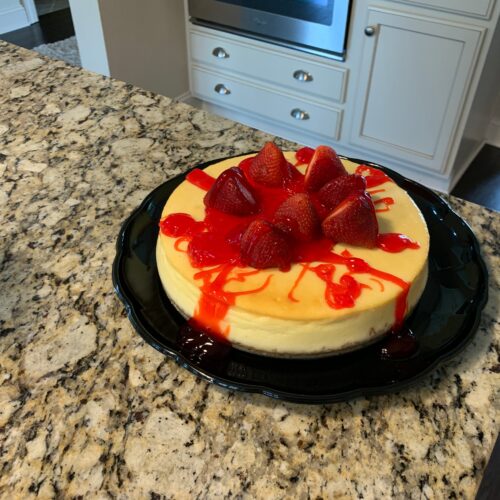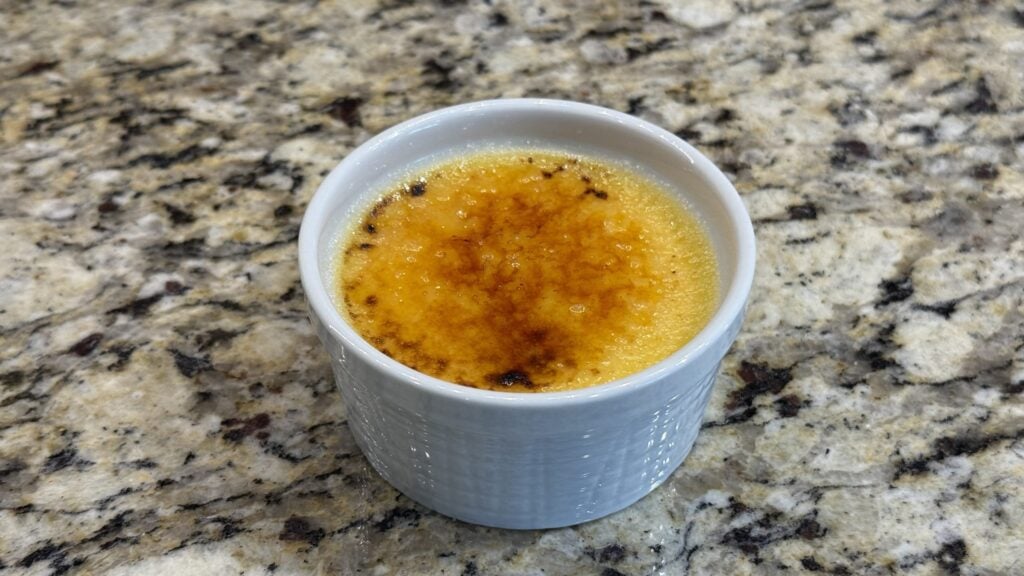
Classic New York-Style Cheesecake
A rich, creamy, and crack-free cheesecake made easy for beginners!Make Ahead: The cheesecake can be stored in the fridge, tightly covered, for up to 2 days.Freezer-Friendly: Freeze the cheesecake for up to 3 months. To freeze, wrap it tightly in aluminum foil or plastic wrap after chilling, and thaw in the fridge overnight before serving.Pro Tip: Ensure your springform pan is properly wrapped in heavy-duty foil to prevent water from seeping in during the water bath. Even if condensation forms, don’t worry – it won’t affect the cheesecake significantly
Equipment
- 1 Springform Pan Nonstick This is essential for making cheesecake because the sides can be easily removed without disturbing the cake
- 1 Reynolds Wrap Heavy Duty Aluminum Foil You’ll need this to wrap the springform pan and prevent water from seeping into the cake during the water bath.
- 1 KitchenAid Artisan Series 5 Quart Tilt Head Stand Mixer A stand mixer or an electric hand mixer helps to evenly blend the cheesecake batter.
- 1 Circulon Nonstick Roasting Pan This is required for the water bath. The springform pan will be placed inside this pan, with water surrounding it to ensure even baking.
- 1 Amazon Basics Electric Kettle You’ll need a kettle to boil water for the water bath.
- 1 Organic Extra Virgin Olive Oil Non-Stick Cooking Spray Used to prepare the springform pan so the cheesecake doesn’t stick to the sides.
Ingredients
For the Crust:
- 1½ cups graham cracker crumbs from 12 whole crackers
- 5 tablespoons unsalted butter melted
- 2 tablespoons sugar
- 1/8 teaspoon salt
For the Filling:
- 32 oz four 8-oz blocks cream cheese, at room temperature
- 2 cups sugar
- 3 tablespoons all-purpose flour
- 4 teaspoons vanilla extract
- 1 teaspoon packed lemon zest from 1 lemon
- 2 teaspoons fresh lemon juice from 1 lemon
- ¼ teaspoon salt
- 6 large eggs
- ½ cup sour cream
Instructions
Prepare the Crust
- Preheat the oven to 375°F and set an oven rack in the lower middle position.
- Wrap the springform pan with two sheets of heavy-duty aluminum foil, ensuring no seams on the bottom or sides. Spray the inside with nonstick cooking spray.
- In a medium bowl, mix the graham cracker crumbs, melted butter, sugar, and salt until well combined.
- Press the mixture evenly onto the bottom of the prepared pan.
- Bake the crust for 10 minutes. Remove from the oven and set aside.
- Reduce the oven temperature to 325°F.
Make the Cheesecake Batter
- In the bowl of an electric mixer, combine the cream cheese, sugar, and flour. Beat on medium speed until smooth (about 1 minute).
- Add the vanilla, lemon zest, lemon juice, and salt. Beat on low speed until just combined.
- Add the eggs, one at a time, mixing on low speed. Scrape the bowl as necessary.
- Finally, mix in the sour cream. Be careful not to over-mix.
Bake the Cheesecake
- Pour the cheesecake batter over the cooled crust.
- Set the springform pan in a large roasting pan. Pour boiling water into the roasting pan until it reaches about 1 inch up the side of the springform pan.
- Bake for 1 hour 30 minutes to 1 hour 45 minutes. The cheesecake should wobble slightly in the center but not look liquid.
- Remove from the oven and cool in the water bath for 45 minutes. Then transfer the cheesecake to the fridge and let cool for at least 8 hours or overnight.
- Remove the sides of the springform pan. Serve directly from the base or transfer the cheesecake to a serving platter using a long, thin spatula. Slice the cheesecake with a sharp knife, wiping the blade between slices. Optional: Serve with berry sauce.
Notes
The Background and History of New York-Style Cheesecake
New York-style cheesecake is not only a staple of American desserts but has a rich and fascinating history that spans centuries, cultures, and continents. This classic dessert is revered for its dense, creamy texture, smooth flavor, and indulgent richness. Its story is deeply rooted in the cultural melting pot that is New York City, yet its origins can be traced back far beyond American borders. Understanding the background and evolution of this beloved treat adds layers of depth to its simple yet refined ingredients.The Ancient Origins of Cheesecake
While New York-style cheesecake is a relatively modern invention, the concept of cheesecake is ancient. The earliest known form of cheesecake dates back to ancient Greece, nearly 4,000 years ago. Historians believe that the first cheesecakes were made on the island of Samos, where the Greeks used simple ingredients like fresh cheese, flour, and honey to form a rudimentary cake. These early cheesecakes were not only used as a popular treat but also as a source of sustenance for athletes during the first Olympic games in 776 BC. Interestingly, these early Greek cheesecakes were quite different from what we recognize today. They were less sweet, less creamy, and more bread-like. The Greeks even had a cheesecake recipe written down by Athenaeus, a Greek writer in 230 AD, showing how beloved the dessert was in the ancient world. The Roman Empire later adopted the Greek version of cheesecake, refining the recipe by adding eggs and baking it under hot bricks. As the Romans expanded their empire, they spread the cheesecake concept throughout Europe.The European Evolution of Cheesecake
In medieval Europe, the use of dairy in baked goods became more widespread, and various versions of cheesecake began to emerge. In Italy, ricotta cheese was often used, creating a lighter, slightly tangy version of cheesecake. In France, neufchâtel cheese (an ancestor of cream cheese) became popular, leading to a creamier, softer cheesecake. Each European region had its unique twist on the dish, influenced by available ingredients and local culinary traditions. During the Renaissance, cheesecake became a staple in royal banquets across Europe, and it began evolving closer to the dessert we know today. Sugar became more readily available, and cheesecakes became sweeter. The British, who had developed a fondness for baked cheese-based desserts, brought their version of cheesecake to the American colonies in the 1700s, where it began its journey toward becoming the iconic New York-style cheesecake.The American Cheesecake Revolution
The recipe for cheesecake took root in America during the colonial period, but it wasn’t until the late 19th century that it began to take the form we recognize today. As European immigrants came to America, they brought their regional recipes with them, including their beloved cheesecakes. At the time, cheesecakes in America were made primarily with soft cheeses like cottage cheese or farmer’s cheese, resulting in a lighter, less creamy texture. In 1872, however, an unexpected event changed the future of cheesecake in America. A dairy farmer in Chester, NewYork, named William Lawrence, accidentally invented modern cream cheese while trying to replicate the soft French neufchâtel cheese. Lawrence’s cream cheese was richer, creamier, and denser than its French counterpart. It became an instant hit, leading to the founding of the now-iconic Philadelphia Cream Cheese brand in 1880. Cream cheese quickly became a favored ingredient in American cheesecake recipes, as it provided a richer, denser texture that differentiated it from earlier versions made with ricotta or cottage cheese. The invention of cream cheese is often credited as the turning point in the history of New York-style cheesecake, as it allowed bakers to create the thick, smooth, creamy cakes that became synonymous with New York.The Birth of New York-Style Cheesecake
New York City in the early 20th century was a melting pot of cultures and cuisines, and it was during this time that the iconic New York-style cheesecake began to take shape. Jewish immigrants from Eastern Europe played a significant role in developing this now-famous dessert. Many Jewish delis and bakeries in New York, especially in the Lower East Side, began offering their own versions of cheesecake, using cream cheese as the base. One of the key figures in the history of New York-style cheesecake is Arnold Reuben, a German-Jewish immigrant who owned Reuben’s Restaurant and Delicatessen. Reuben, who is also credited with inventing the Reuben sandwich, is believed to have created the first true New York-style cheesecake in the 1920s. His cheesecake was made with a rich cream cheese filling, a touch of lemon for acidity, and a graham cracker crust (though some early versions were made with a sponge cake base). Reuben’s version became incredibly popular and is often considered the prototype for the classic New York-style cheesecake we enjoy today. While other variations of cheesecake were popular across America—many using different cheeses like ricotta or farmer’s cheese—New York’s version stood out for its use of cream cheese, dense texture, and rich flavor. The combination of tangy cream cheese, eggs, sugar, and often a touch of sour cream created a dessert that was thick and luxurious, yet not overwhelmingly sweet.What Makes New York-Style Cheesecake Unique?
So, what is it that sets New York-style cheesecake apart from other varieties? There are several key characteristics that define this iconic dessert:- Cream Cheese Base: The primary ingredient in New York-style cheesecake is cream cheese, which gives the cake its signature dense and smooth texture. Other types of cheesecake, like Italian or French versions, often use ricotta or mascarpone, which creates a lighter, fluffier consistency. Cream cheese, on the other hand, adds richness and tang, creating a more substantial dessert.
- No Fussy Flavors: Traditional New York-style cheesecake is all about simplicity. It is typically flavored with just a touch of vanilla, lemon zest, or a bit of sour cream to balance the richness of the cream cheese. The focus is on the smooth, creamy filling, rather than on elaborate toppings or fillings. This purity of flavor is what gives New York cheesecake its iconic status.
- Baked in a Water Bath (Bain-Marie): New York cheesecake is almost always baked in a water bath, a technique that ensures even baking and helps prevent cracks. The water bath surrounds the cake in steam, keeping the air in the oven moist and the temperature consistent. This prevents the cheesecake from drying out or developing unsightly cracks on top.
- Dense, Rich Texture: One of the hallmarks of New York-style cheesecake is its incredibly dense, creamy texture. While some cheesecakes are light and airy, New York-style is substantial, almost like a custard. The high fat content of the cream cheese, combined with eggs and often sour cream, gives the cake its velvety smoothness.
- Graham Cracker Crust: While early versions of New York cheesecake sometimes used a sponge cake or shortbread crust, today’s classic version almost always features a graham cracker crust. The crumbly, slightly sweet crust provides a perfect textural contrast to the creamy filling and is an essential component of the modern New York cheesecake experience.
The Cheesecake Boom: From Delis to Diners
After its invention in the 1920s, New York-style cheesecake quickly became a beloved dessert, not just in New York City but across America. Jewish delis and bakeries throughout New York were known for their cheesecake, and each establishment had its own variation of the recipe. Some of the most famous spots for New York cheesecake included Lindy’s, Junior’s, and Carnegie Deli. Lindy’s, in particular, was a landmark. Opened in 1921 by Leo Lindemann, Lindy’s became famous for its cheesecake, which was so iconic that it was frequently mentioned in movies, television shows, and Broadway plays. Lindy’s cheesecake was known for its rich, dense filling and delicate graham cracker crust, and for decades, it was considered the gold standard of New York-style cheesecake. Junior’s, another legendary New York establishment, opened in Brooklyn in 1950 and quickly gained fame for its cheesecake. Junior’s version is slightly different from Lindy’s, using a sponge cake base rather than a graham cracker crust. Nevertheless, it became just as popular, and today, Junior’s cheesecake is still considered one of the best in New York. In the decades that followed, New York-style cheesecake made its way beyond the city’s delis and bakeries and into diners, restaurants, and home kitchens across the country. By the mid-20th century, cheesecake had become a quintessential American dessert, with New York-style leading the charge.Modern Variations and Innovations
While the classic New York-style cheesecake recipe has remained relatively unchanged over the years, modern chefs and bakers have found creative ways to put their own spin on the dessert. Today, you can find variations of New York cheesecake featuring a wide range of flavors and toppings. Some popular variations include:- Fruit Toppings: Strawberries, blueberries, or cherries are often used to add a burst of color and flavor to the top of the cheesecake. A simple fruit compote or fresh berries provide a tart contrast to the rich filling.
- Chocolate Swirls or Chips: For chocolate lovers, swirls of chocolate or the addition of chocolate chips to the filling can add a decadent touch to the classic cheesecake.
- Flavor Additions: While traditional New York-style cheesecake sticks to vanilla and lemon, many modern versions incorporate additional flavors like caramel, espresso, or even pumpkin to give the dessert a unique twist.
- Crust Variations: Although graham cracker crust is the standard, some bakers experiment with crusts made from crushed Oreos, digestive biscuits, or even shortbread cookies.
Nutrition
Calories: 3024kcalCarbohydrates: 543gProtein: 15gFat: 93gSaturated Fat: 50gPolyunsaturated Fat: 4gMonounsaturated Fat: 25gTrans Fat: 2gCholesterol: 218mgSodium: 1752mgPotassium: 440mgFiber: 5gSugar: 458gVitamin A: 2466IUVitamin C: 1mgCalcium: 242mgIron: 7mg
Tried this recipe?Let us know how it was!



